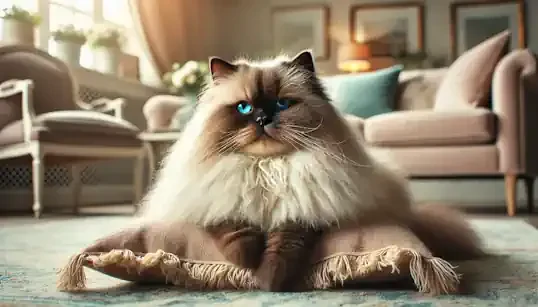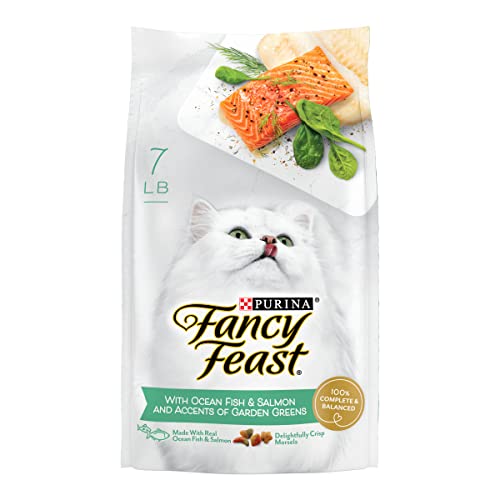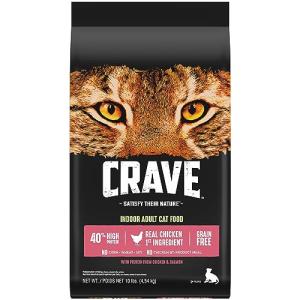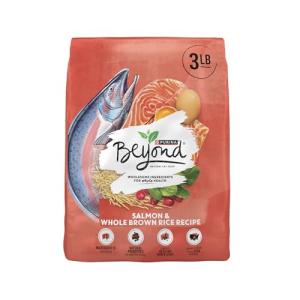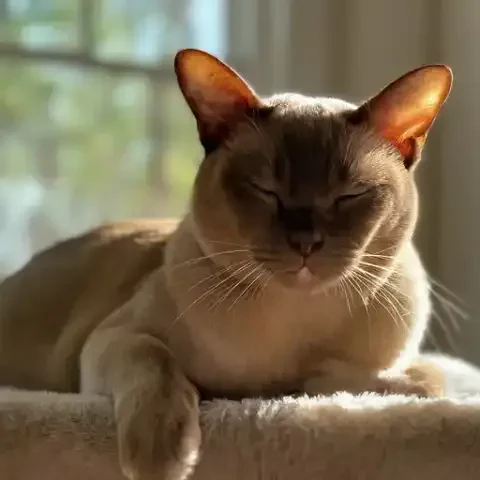Picture a cat with the luxurious coat of a Persian, the mesmerizing blue eyes of a Siamese, and a uniquely captivating "pointed" pattern. If you find yourself drawn to cats that seamlessly blend elegance with a gentle and affectionate nature, then the Himalayan cat might just capture your heart. This breed, a beautiful tapestry woven from the threads of two iconic feline lineages, offers a unique combination of striking visual appeal and a temperament that is as sweet as it is calm. This article will delve into the captivating world of the Himalayan cat, exploring the origins of this beloved breed, their exquisite physical traits, their endearing personality, and the essential aspects of caring for these glamorous companions. Whether you are a seasoned cat lover or just beginning your journey into the world of feline companionship, prepare to be enchanted by the allure of the Himalayan.
Unlike breeds that evolved naturally over centuries, the Himalayan cat is a testament to deliberate design, a "man-made" marvel intentionally crafted to combine the most desirable traits of two distinct breeds: the Persian and the Siamese. The story of the Himalayan is one of dedicated breeders seeking to create a "colorpoint Persian," a cat that would possess the coveted Persian body type and luxurious coat, but adorned with the striking colorpoint pattern and captivating blue eyes characteristic of the Siamese. The vision was clear: to meld the plushness and gentleness of the Persian with the contrasting colors and piercing blue gaze of the Siamese, resulting in a feline that would be both visually stunning and temperamentally delightful.
To achieve this ambitious goal, breeders meticulously crossbred Persians and Siamese cats over several generations. They carefully selected individuals that exhibited the desired traits, gradually refining the Himalayan lineage to consistently produce cats that embodied the intended combination. From the Persian parent breed, the Himalayan inherited its signature long, flowing, and dense coat, as well as its cobby, rounded body shape and gentle, docile temperament. Persians, renowned for their luxurious fur and placid nature, contributed the foundation of the Himalayan’s physical and temperamental blueprint. From the Siamese lineage, the Himalayan received the distinctive colorpoint pattern – the contrasting darker color on the extremities like ears, face mask, legs, and tail – and, most importantly, the mesmerizing, sapphire-blue eyes that are a defining characteristic of the breed. While Siamese cats are known for their vocal and sometimes more active personalities, the Himalayan inherited a tempered version of this energy, resulting in a cat that is playful but generally more moderate in its activity levels.
The early experimental breeding programs began in the early to mid-20th century, with breeders in both the United States and Europe working independently towards the same goal. As the Himalayan type became more consistent and recognizable, efforts were made to gain official breed recognition from cat registries. Key milestones were reached as different cat organizations began to acknowledge the Himalayan. The Cat Fanciers' Association (CFA), one of the largest cat registries in North America, granted the Himalayan breed status in 1957. However, it's important to note that even within cat fancy circles, the classification of the Himalayan varies. In some registries, like the CFA, the Himalayan is considered a colorpoint variety of the Persian cat, essentially a Persian distinguished by its colorpoint pattern. In other registries, particularly in Europe, the Himalayan is recognized as a separate and distinct breed in its own right. Regardless of classification, the Himalayan's popularity quickly soared, establishing itself as a beloved and sought-after feline breed around the world. Understanding this intentionally crafted heritage adds another layer of appreciation for the Himalayan, showcasing it as a breed born from a clear vision and realized through careful dedication and selective breeding.
The Himalayan cat is a breathtaking embodiment of feline beauty, seamlessly merging the plushness of the Persian with the striking contrasts of the Siamese. Their overall appearance is one of rounded softness and luxuriousness, dominated by their glorious coat and captivating blue eyes. Inherited directly from their Persian ancestors, the Himalayan boasts a cobby, round body shape. They are substantially built, with a solid and well-balanced physique that conveys a sense of robustness beneath their flowing fur. Their legs are short and thick, contributing to their grounded appearance, and their chest is broad and deep, further enhancing their sturdy build. This is not a delicate or fragile cat; they possess a substantial presence that feels reassuringly solid when you hold them.
The Himalayan’s coat is, without question, one of their most defining and captivating features. It is a Persian-type coat in every sense: long, flowing, dense, and utterly luxurious. The fur is thick and full, creating a soft, cloud-like appearance that begs to be touched. Its texture is exquisitely fine and silky, cascading gracefully around their body and creating a truly opulent visual effect. Adding to the coat's grandeur is the full ruff that encircles their neck, framing their face in a halo of soft fur. Their tail, too, is gloriously plumed, carried with a regal air and adding the finishing touch to their luxurious silhouette.
However, what truly sets the Himalayan apart visually is their distinctive colorpoint pattern, inherited from their Siamese ancestry. This pattern is characterized by a lighter body color contrasted with darker coloration on the "points" – the ears, face mask, legs, and tail. The body color is typically a creamy white or pale fawn, providing a beautiful canvas for the contrasting points. The variety of point colors in Himalayans is quite diverse, offering a spectrum of visual delights. Seal point Himalayans exhibit rich, dark brown to almost black points, creating a classic and striking contrast. Blue point Himalayans display soft, bluish-grey points, offering a cooler and more ethereal aesthetic. Chocolate points are a warmer, milk-chocolate brown, while lilac points are the palest and most delicate, a frosty grey with pinkish undertones. Red and cream points introduce warmer hues, ranging from orange-red to soft apricot. Tortie points are a captivating mosaic of tortoiseshell colors intermingled with the base point color, creating a unique and individual pattern in each cat. Blue-cream points similarly combine blue and cream hues. Furthermore, variations like Lynx (or Tabby) points introduce stripes or tabby markings within the point color, adding another layer of complexity. Newer color variations and combinations continue to emerge, expanding the already rich palette of Himalayan coat colors.
Amidst this tapestry of fur and color, the Himalayan’s mesmerizing blue eyes shine like sapphires. Deep, intense blue eyes are a breed standard requirement, and they are arguably the most captivating feature of the Himalayan face. The ideal eye shape is round and large, further enhancing their expressive gaze. The deep blue hue creates a striking contrast against their point coloration and adds an undeniable element of allure and mystique to their overall appearance. Completing their sweet and gentle facial features is their rounded head, short nose, and full cheeks, all contributing to their soft and amiable expression. While their facial features are less extreme than some Persian lines, they still possess the characteristic roundness and open, expressive face that is part of the Persian breed’s charm. Their ears are small and rounded, often set wide apart on their head and tilting slightly forward, adding a touch of alertness to their overall gentle countenance. In essence, the Himalayan's appearance is a meticulously crafted masterpiece, a harmonious blend of Persian plushness and Siamese points, culminating in a feline of exquisite and unforgettable beauty.
Beyond their undeniable physical beauty, the Himalayan cat possesses a temperament that is as endearing as their appearance is captivating. They are renowned for their gentle, sweet, and docile nature, making them exceptionally pleasant companions in a variety of households. Their reputation for gentleness is well-deserved. Himalayans are known to be calm, easygoing, and generally well-mannered cats. They are less prone to the more boisterous or demanding behaviours sometimes seen in more active breeds. Their tranquil disposition makes them ideally suited to calmer home environments and owners seeking a peaceful and harmonious feline companion. This gentle nature extends to their interactions with humans; they are generally tolerant, patient, and rarely exhibit aggression, making them wonderful companions for families with children and multi-pet households (with proper introductions).
Despite their relaxed demeanor, Himalayans are deeply affectionate and devoted to their families. They thrive on human companionship and relish attention and gentle affection. While they may not be as overtly demanding as some breeds, they appreciate lap time and enjoy cuddling with their favourite humans. They form strong bonds with their owners and are fiercely loyal, often becoming deeply attached to one or more individuals within the household. Their affection is often expressed through gentle purrs, soft head bumps, and a quiet presence nearby, always wanting to be in the vicinity of their beloved humans.
While not as overtly energetic as Siamese cats, Himalayans do possess a playful side. They enjoy gentle games and will engage in playful batting at toys, chasing soft toys, and enjoying interactive play sessions. However, their playfulness is generally more moderate and less intense compared to more active breeds. They are content with shorter play sessions and are equally happy to spend time lounging and observing their surroundings. Suitable toys for Himalayans include soft toys they can bat around, feather wands for gentle interactive play, and puzzle toys that stimulate their minds without requiring excessive physical exertion.
Himalayans are intelligent cats and capable of learning, although their motivation may be more driven by affection than by a desire to "work" in the traditional sense. They can learn simple commands and may enjoy puzzle toys that challenge their problem-solving skills. However, they are not typically known for being highly trainable in complex tricks. Their intelligence is more subtly expressed in their ability to understand household routines, recognize their names, and adapt to their environment. Socially, Himalayans are generally well-adjusted within their families. They typically get along well with children and other pets, especially when introduced gradually and raised together. However, they can be more reserved or initially shy around strangers. They may take time to warm up to new people and prefer familiar faces and comfortable routines. In summary, the Himalayan personality is a beautiful reflection of their blended heritage: gentle, affectionate, playful in moderation, and deeply devoted to their families, making them truly wonderful and calming companions for those seeking a loving and elegant feline presence.
Caring for a Himalayan cat is a commitment that centers around two key aspects: their magnificent coat and their predisposition to certain health concerns stemming from their Persian ancestry. First and foremost, be prepared for extensive grooming. Their long, dense, Persian-type coat demands significant daily attention to prevent matting, tangles, and the build-up of loose fur. Daily brushing is not merely recommended; it is essential. A thorough brushing session should be incorporated into your daily routine to keep their coat healthy, clean, and free of knots. Utilize appropriate grooming tools such as a slicker brush to remove loose fur and prevent mats, a metal comb to work through any tangles, and potentially a mat splitter or detangler spray for more stubborn knots. Regular bathing is also a necessity for Himalayans. Plan to bathe them every few weeks to maintain coat cleanliness, remove accumulated oils and debris, and keep their fur looking its best. Use a cat-specific shampoo and conditioner to avoid skin irritation and maintain the coat's natural luster. For owners who find the extensive grooming demands challenging to manage at home, seeking professional grooming services is a worthwhile consideration. A professional groomer experienced with long-haired breeds can provide thorough bathing, brushing, and even trimming if needed, ensuring your Himalayan’s coat remains healthy and beautiful.
Nutrition plays a crucial role in maintaining the health and coat quality of your Himalayan. Feed them a high-quality cat food appropriate for their age, indoor lifestyle (as Himalayans are typically indoor cats), and any specific dietary needs. Choose a food that is rich in protein and formulated to support healthy skin and coat. Portion control is particularly important for Himalayans. Their less active nature and Persian heritage can make them prone to weight gain if overfed. Adhere to feeding guidelines and monitor their weight to prevent obesity, which can exacerbate other health issues. Fresh, clean water should always be readily available to ensure proper hydration, contributing to overall health and well-being.
While not as overtly energetic as some breeds, Himalayans still require moderate exercise and playtime to stay physically and mentally stimulated. Engage them in gentle play sessions daily, providing toys that encourage movement without being overly strenuous. Scratching posts and cat trees offer opportunities for stretching and climbing, while soft toys and feather wands can encourage gentle batting and chasing. Avoid overexertion, especially in warmer weather, given their heavy coat, which can make them prone to overheating.
It is essential to be aware of the health considerations associated with the Himalayan breed, primarily stemming from their Persian lineage. Polycystic Kidney Disease (PKD) is a significant concern in Persians and, consequently, in Himalayans. PKD is a hereditary condition that causes cysts to form on the kidneys, potentially leading to kidney failure. When acquiring a Himalayan, especially a kitten, it is crucial to choose a breeder who actively tests their breeding cats for PKD and guarantees that their kittens are from PKD-negative lines. Progressive Retinal Atrophy (PRA) is another potential hereditary eye condition in Persians and Himalayans that can lead to vision loss. Responsible breeders will screen for PRA as well. Brachycephalic issues, related to their flattened facial structure inherited from Persians, can sometimes manifest as mild breathing difficulties, particularly in Himalayans with more extreme facial features. Tear staining around the eyes is a common cosmetic issue due to their facial structure and tear duct anatomy. Daily cleaning of the eye area is usually necessary to prevent tear stains from becoming prominent and potentially leading to skin irritation. Other potential health concerns, although less breed-specific, include Hypertrophic Cardiomyopathy (HCM), a heart condition, and dental problems, which are common in many cat breeds. Regular veterinary checkups are paramount for preventative care and early detection of any health issues. Choose a veterinarian experienced with feline breeds and discuss breed-specific health concerns and preventative measures. Due to their valuable coats, gentle nature, and potential health sensitivities, an indoor lifestyle is strongly recommended for Himalayans. Indoor living protects them from traffic, predators, diseases, and the elements, ensuring a safer and healthier life. In summary, caring for a Himalayan cat is a fulfilling but demanding commitment that prioritizes extensive grooming and proactive health management, ensuring these gentle and glamorous companions thrive in their loving homes.
